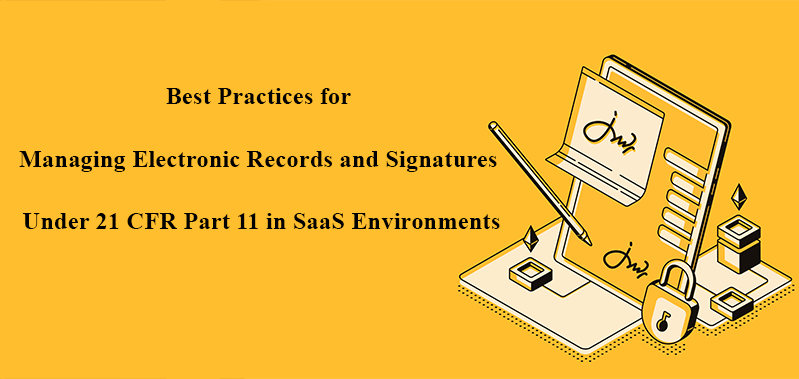
Best Practices for Managing Electronic Records and Signatures Under 21 CFR Part 11 in SaaS Environments
In today’s rapidly evolving digital landscape, software-as-a-service (SaaS) platforms have become a cornerstone for many organizations, offering scalability, flexibility, and cost-efficiency. However, for companies in regulated industries such as pharmaceuticals, biotechnology, and medical devices, ensuring compliance with 21 CFR Part 11 remains a critical responsibility. This regulation governs electronic records and electronic signatures, ensuring that these digital formats meet the same stringent standards as paper-based records.
To successfully manage electronic records and signatures in SaaS environments, understanding and implementing the best practices for 21 CFR Part 11 compliance is essential. Failure to comply not only risks regulatory penalties but could also compromise the integrity of data, affecting patient safety and product quality.
What is 21 CFR Part 11?
21 CFR Part 11 is a regulation established by the U.S. Food and Drug Administration (FDA) that sets criteria for electronic records and electronic signatures (ERES) in industries regulated by the FDA. These rules are designed to ensure that electronic records and signatures are trustworthy, reliable, and equivalent to paper records. In SaaS environments, this regulation applies to any software or platform that stores, processes, or manages regulated data.
Best Practices for Compliance with 21 CFR Part 11
-
Vendor Assessment and Qualification
A fundamental starting point is choosing a SaaS provider that demonstrates its ability to support compliance with 21 CFR Part 11. Perform a detailed vendor audit to assess their policies, controls, and systems for maintaining data integrity and security. The vendor should provide clear documentation of their quality management system, including adherence to change controls, data security, and audit trails. - Access Control and User Management
Proper access control ensures that only authorized personnel have access to electronic records and the ability to sign electronically. Implement role-based access controls (RBAC), which restrict permissions based on job functions. For enhanced security, consider integrating multi-factor authentication (MFA) to mitigate unauthorized access risks. Regularly review and update user permissions to reflect changes in staff roles or responsibilities. - Audit Trails
One of the critical requirements of 21 CFR Part 11 is the maintenance of secure, computer-generated audit trails that log all changes made to electronic records. These audit trails must capture the identity of the user making the changes, the time and date of changes, and the nature of the changes. SaaS systems should automatically generate these audit trails and make them tamper-proof. Regularly review audit trails to ensure system integrity. - Data Integrity and Backup
Data integrity is a core principle of 21 CFR Part 11, and in SaaS environments, the responsibility for data security may be shared between the service provider and the client. Implement controls to ensure that data is accurate, complete, and accessible when required. Regularly back up data and establish recovery processes in case of system failures or data corruption. All backup processes must comply with Part 11, ensuring data is not lost or altered. - Electronic Signature Controls
In compliance with 21 CFR Part 11, electronic signatures must be uniquely assigned to individuals and cannot be reused or reassigned. These signatures must also be linked to their corresponding records in such a way that they cannot be altered or removed. Implement verification processes, such as password protection or biometrics, to ensure the authenticity of electronic signatures. Ensure that users are trained on the importance of safeguarding their credentials. - Documented Procedures and Training
All processes related to the management of electronic records and signatures must be documented, including detailed standard operating procedures (SOPs). These SOPs should outline system operations, validation requirements, user responsibilities, and contingency plans. Regular training programs are essential to ensure that employees understand their role in maintaining compliance with 21 CFR Part 11. - System Validation
System validation is the process of ensuring that your SaaS environment operates in compliance with regulatory requirements and meets intended use. This involves rigorous testing to ensure the system performs as expected under various conditions. Maintain detailed records of all validation activities, including test results, and document any corrective actions taken if the system does not perform as required. Validation activities should be part of an ongoing process, especially when updates or changes are made to the system. - Change Control Management
SaaS platforms often undergo regular updates or patches. Implementing a change control management system helps ensure that any changes do not affect compliance. Document each change, perform a risk assessment, and revalidate the system if necessary. Establish clear communication channels with your SaaS provider to stay informed about updates and assess their impact on your system. - Periodic System Review
Periodic review of SaaS systems is critical to maintaining long-term compliance with 21 CFR Part 11. Regularly evaluate your system for performance, data integrity, security, and adherence to SOPs. Identify and address any gaps in compliance, and ensure continuous improvement to mitigate evolving risks.
Conclusion
Compliance with 21 CFR Part 11 is non-negotiable for companies handling regulated data, and SaaS environments introduce both unique opportunities and challenges in managing electronic records and signatures. By following these best practices—choosing the right vendor, maintaining audit trails, ensuring data integrity, and conducting regular system validation—organizations can successfully navigate the complexities of compliance while leveraging the benefits of SaaS.




